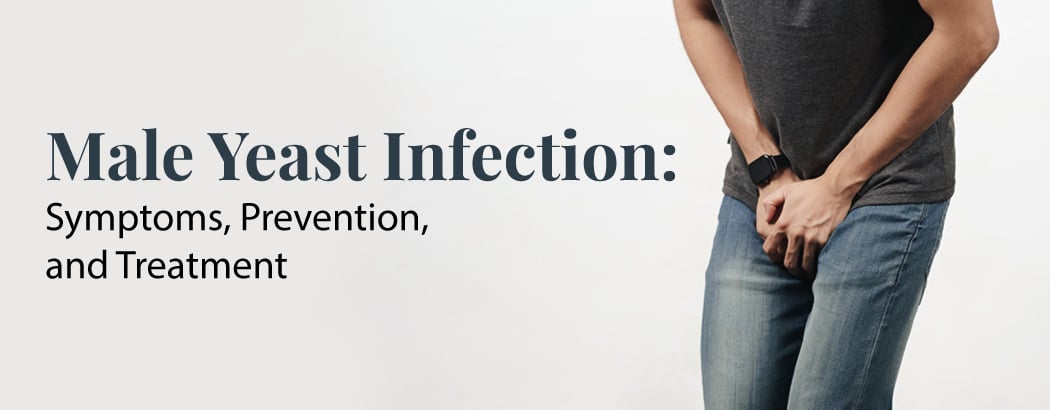Male Yeast Infection: Symptoms, Prevention, and Treatment
February 5, 2024

Male Yeast Infection
A yeast known as Candida is the source of a fungal infection in men. Candida balanitis is another name for it. A red, itchy rash appears on the head of the penis when you have Candida balanitis. Candida thrives in warm, humid settings, like the skin on the outside of uncircumcised individuals. Usually, antifungal cream is used as part of the treatment.
Contents
Yeast Infection
Yeast infection is caused by the fungus called candida . It is an infection primarily of the nails and skin.It is not uncommon to get yeast infections. This is particularly valid for yeast infections in the vagina. But yeast infections aren’t limited to the vagina. In addition to the penis, they can also appear in the mouth, throat, and other parts of the body.
In regular amounts, candida is usually harmless.
Male Yeast Infection
A yeast infection that affects the penis is called a male yeast infection. Candida balanitis is the medical word used to describe yeast infections in men. One kind of yeast that causes yeast infections is called Candida. An infection or inflammation of your penis’s head is known as balanitis (glans penis).
Candida is one of the various types of yeast that reside on your skin. This typically has no negative effects on healthy individuals. However, Candida overgrowth has the ability to penetrate your skin’s surface. A rash or skin infection may result from this. Wet, warm conditions are ideal for the growth and survival of candida. It is frequently discovered in moist, wrinkled places, like your penis’ foreskin.
Symptoms of Male Yeast Infections
Pain, swelling, and redness in the groin area are signs of a male yeast infection. Usually, there are spots of redness. Some other possible additional symptoms are:
- Burning, itching, and irritation under your foreskin and around the head of your penis .
- A white discharge that is thick and cottage cheese-like.
- An odorous discharge
- Pulling back your foreskin is difficult.
- Shiny blisters or ulcers on your penis.
- Slight lumps that resemble rashes and may contain pus
- Discomfort during intercourse
- Spots of glossy, white skin near the top of the penis
Causes of Male Yeast Infections
Although the Candida fungus is typically found on skin and in the environment, an infection can occur when the correct circumstances allow it to proliferate. The candida yeast has a preference for warm, humid environments and can rapidly grow in areas of the body that sweat a lot.These causes can be:
- Candida overload: Risk factors for candida include indiscriminate antibiotic use, weakened immune systems, and bad diets. These conditions might cause an increase in candida.
- Use of antibiotics: Antibiotics have the potential to upset the delicate balance of bacteria in your body if you use them frequently. An infection results from allowing candida to grow unrestrained if that balance is off.
- High sugar intake and diabetes: A high sugar content is ideal for the growth of yeast. Thus, if you have diabetes and you are unable to control your blood sugar, you may develop a yeast infection.
- Weak immune system: Your body could have trouble suppressing the growth of candida if you have a weak immune system from illness or medication. A yeast infection may arise from this.
- Transmission by Sex: Though they are not sexually transmitted infections, you may contract one if your partner is infected.
Risk Factors for Male Yeast Infections
Men are at a higher risk of developing yeast infections due to a number of variables, such as:
- Failure to maintain genital cleanliness
- Lack of circumcision
- Weakened immune system (due to illness, a chronic health condition, or medication)
- Tight-fitting underwear or wet clothing
- Hot, humid environments
- Lubricant-containing condoms
- Diabetes (diabetes patients have more sugar in their urine, which allows yeast to grow)
- Being overweight increases a man’s risk of developing yeast infections
Diagnosis of Male Yeast Infection
Seeking a medical professional for a correct diagnosis is essential. If you have a yeast infection, they may diagnose you using a variety of techniques. They are listed below:
- Physical assessment : For indications of a yeast infection, the doctor will examine the afflicted area.
- Use of swab testing: In a swab test, a sample is taken from the afflicted area and sent to a laboratory for analysis. By doing so, you can rule out alternative options and determine whether candida is the root of the problem.
- Blood examinations: Occasionally, the doctor might prescribe blood testing. This can assist in determining whether any underlying medical conditions, such as diabetes or a weakened immune system, are contributing to the yeast infections.
Treatment Options for Male Yeast Infections
Several treatments are available to help lower the infection and alleviate symptoms once a doctor confirms the presence of a yeast infection. Listed below are some treatment options:
Medical treatments : Antifungal medications or lotions are among them. A few of them are sold as over-the-counter medications. Others, however, could require a prescription. Never forget to consult your doctor before beginning any form of drug.
Oral antifungal drug: The doctor may recommend oral antifungal drugs for infections that are more severe or persistent.
When should I see a Doctor?
The right time to visit your doctor would be when and if you see the following symtoms:
- See a doctor if self-care products that you can buy over-the-counter don’t work or if your symptoms are growing worse.
- Consult a doctor if you are prone to recurring yeast infections. They can look for any underlying medical issues that may be contributing to these recurrent infections.
- Seek further evaluation from a physician if your symptoms are severe or worsening.
Conclusion
Though not as frequent as female yeast infections, male yeast infections can nonetheless happen. Poor hygiene or having sex without the use of an external condom with a partner who has a vaginal yeast infection may be the cause of them.
The skin may have little white spots, redness, itching, or burning as symptoms. It may potentially lead to other issues and problems if neglected.Usually, the infection can be treated and the likelihood of long-term problems decreased with topical antifungal ointments and creams.
Frequently Asked Questions
1. What Is the duration of Male Yeast Infections?
Male yeast infections often go away on their own in a matter of days. If not, the signs and symptoms of a male yeast infection might not go away until the end of the prescribed course of therapy, which might take a week to fourteen days, including antibiotics.
2. Can you infect your partner with yeast infections?
It is possible to transmit a yeast infection to your partner during anal, oral, or vaginal sex if they also have one. Any wet part of the body, such as the mouth, vagina, penis, or anal regions, provides a suitable environment for yeast growth.
3. Can yeast infection go away on its own in men?
Depending on your overall health, a penile yeast infection can go away without treatment. But it can also worsen and spread to other areas around the penis. The treatment for a male yeast infection is generally simple. Therefore, starting as soon as possible is important to ensure the infection doesn’t spread.







